MA514 Business Finance: Price-to-Earnings Ratio Analysis Report
VerifiedAdded on 2023/01/07
|8
|1793
|22
Report
AI Summary
This business report provides a comprehensive analysis of the price-to-earnings ratio (P/E) as a tool for share valuation. The report begins with an executive summary and introduction, followed by a detailed examination of the P/E ratio, including its definition and application. The main body critically analyzes the P/E ratio, identifies its limitations, and evaluates the difficulties in using it for share valuation. Furthermore, the report explores the relationship between higher stock prices, agency incentives, and the alignment of interests between managers and shareholders, drawing on agency theory. The report concludes with a summary of the findings and includes a list of relevant references. The analysis covers the advantages and disadvantages of the P/E ratio, considering factors such as volatile stock rates, revenue structures, and market analysts' predictions. The agency theory is applied to analyze the relationship with investors and managers.

Business Report Project
Paraphrase This Document
Need a fresh take? Get an instant paraphrase of this document with our AI Paraphraser
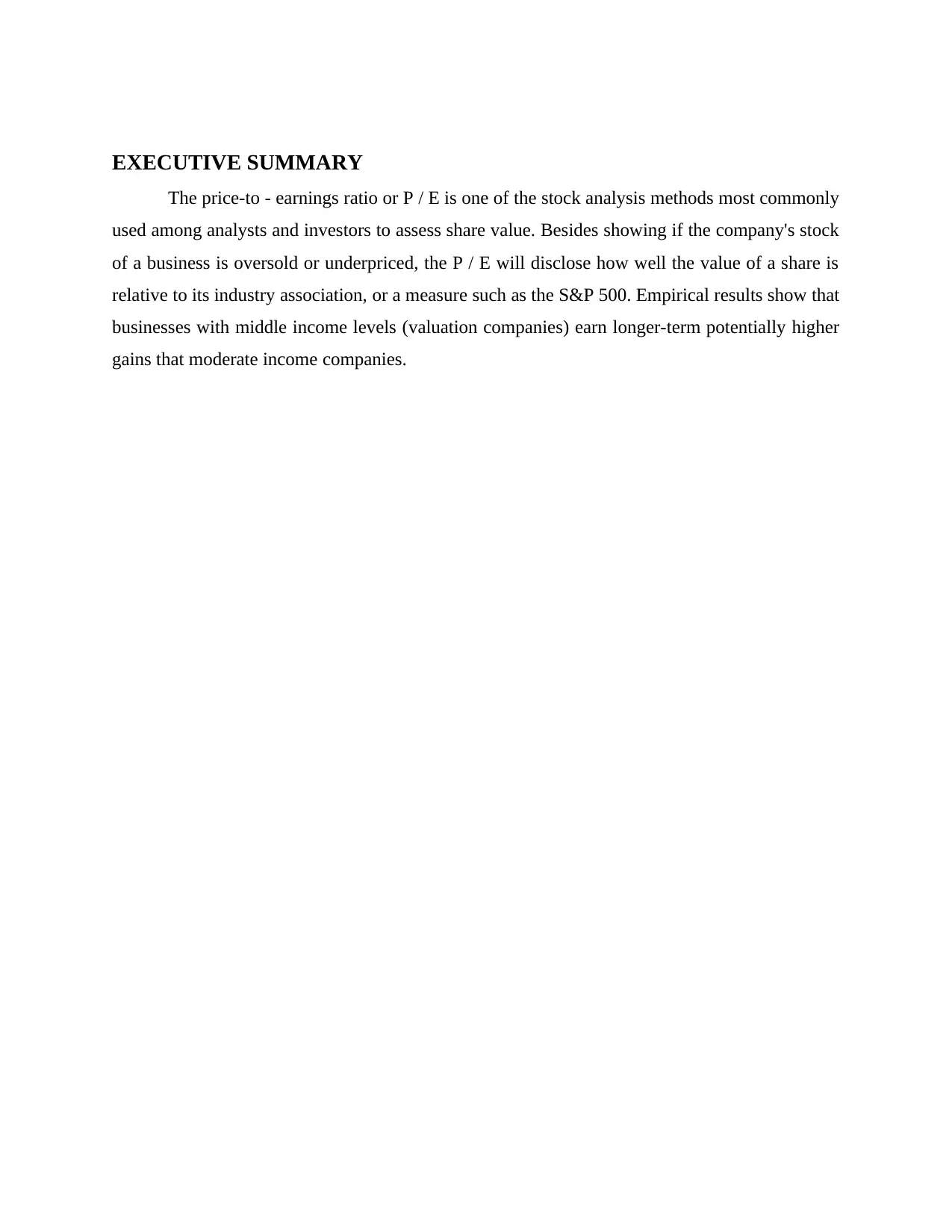
EXECUTIVE SUMMARY
The price-to - earnings ratio or P / E is one of the stock analysis methods most commonly
used among analysts and investors to assess share value. Besides showing if the company's stock
of a business is oversold or underpriced, the P / E will disclose how well the value of a share is
relative to its industry association, or a measure such as the S&P 500. Empirical results show that
businesses with middle income levels (valuation companies) earn longer-term potentially higher
gains that moderate income companies.
The price-to - earnings ratio or P / E is one of the stock analysis methods most commonly
used among analysts and investors to assess share value. Besides showing if the company's stock
of a business is oversold or underpriced, the P / E will disclose how well the value of a share is
relative to its industry association, or a measure such as the S&P 500. Empirical results show that
businesses with middle income levels (valuation companies) earn longer-term potentially higher
gains that moderate income companies.
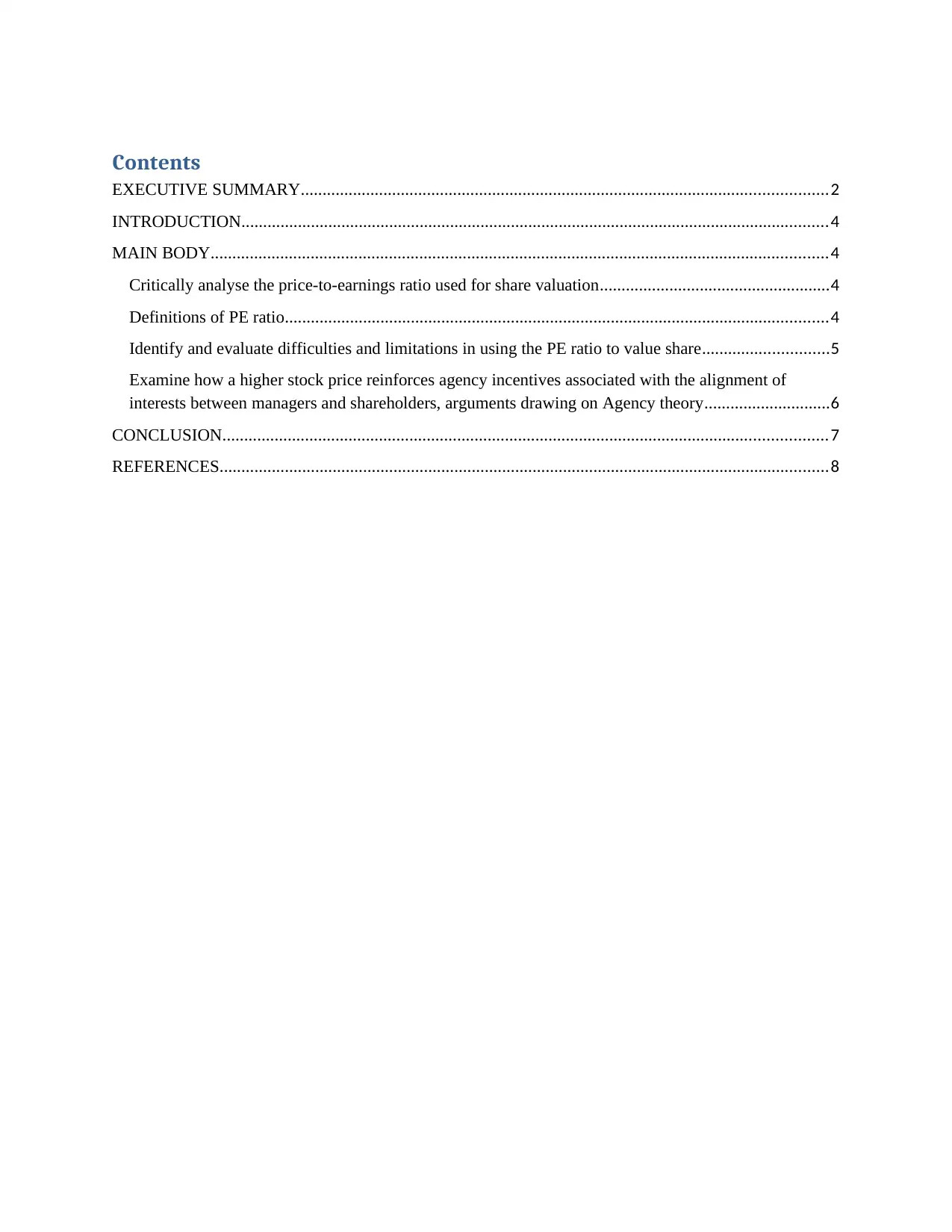
Contents
EXECUTIVE SUMMARY.........................................................................................................................2
INTRODUCTION.......................................................................................................................................4
MAIN BODY..............................................................................................................................................4
Critically analyse the price-to-earnings ratio used for share valuation.....................................................4
Definitions of PE ratio.............................................................................................................................4
Identify and evaluate difficulties and limitations in using the PE ratio to value share.............................5
Examine how a higher stock price reinforces agency incentives associated with the alignment of
interests between managers and shareholders, arguments drawing on Agency theory.............................6
CONCLUSION...........................................................................................................................................7
REFERENCES............................................................................................................................................8
EXECUTIVE SUMMARY.........................................................................................................................2
INTRODUCTION.......................................................................................................................................4
MAIN BODY..............................................................................................................................................4
Critically analyse the price-to-earnings ratio used for share valuation.....................................................4
Definitions of PE ratio.............................................................................................................................4
Identify and evaluate difficulties and limitations in using the PE ratio to value share.............................5
Examine how a higher stock price reinforces agency incentives associated with the alignment of
interests between managers and shareholders, arguments drawing on Agency theory.............................6
CONCLUSION...........................................................................................................................................7
REFERENCES............................................................................................................................................8
⊘ This is a preview!⊘
Do you want full access?
Subscribe today to unlock all pages.

Trusted by 1+ million students worldwide
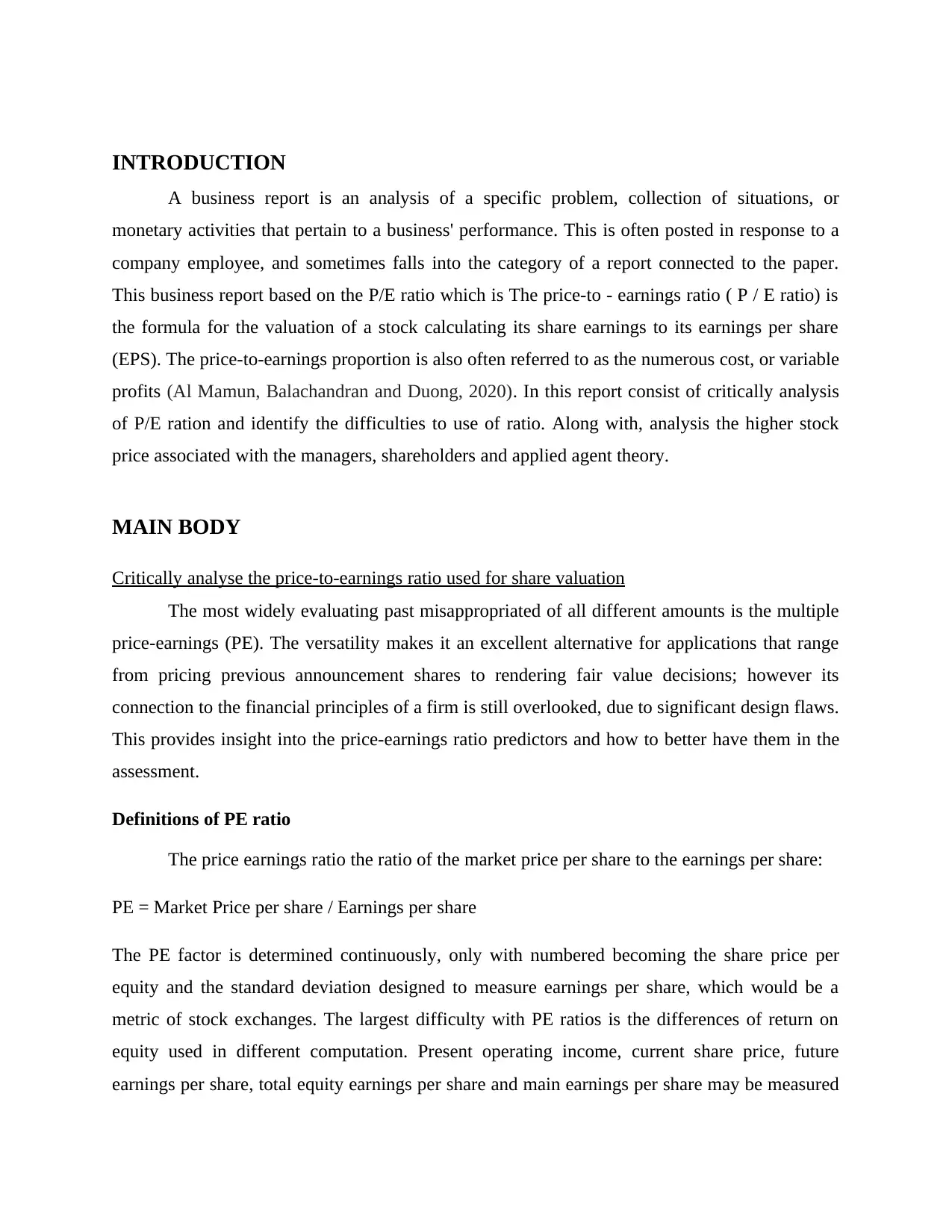
INTRODUCTION
A business report is an analysis of a specific problem, collection of situations, or
monetary activities that pertain to a business' performance. This is often posted in response to a
company employee, and sometimes falls into the category of a report connected to the paper.
This business report based on the P/E ratio which is The price-to - earnings ratio ( P / E ratio) is
the formula for the valuation of a stock calculating its share earnings to its earnings per share
(EPS). The price-to-earnings proportion is also often referred to as the numerous cost, or variable
profits (Al Mamun, Balachandran and Duong, 2020). In this report consist of critically analysis
of P/E ration and identify the difficulties to use of ratio. Along with, analysis the higher stock
price associated with the managers, shareholders and applied agent theory.
MAIN BODY
Critically analyse the price-to-earnings ratio used for share valuation
The most widely evaluating past misappropriated of all different amounts is the multiple
price-earnings (PE). The versatility makes it an excellent alternative for applications that range
from pricing previous announcement shares to rendering fair value decisions; however its
connection to the financial principles of a firm is still overlooked, due to significant design flaws.
This provides insight into the price-earnings ratio predictors and how to better have them in the
assessment.
Definitions of PE ratio
The price earnings ratio the ratio of the market price per share to the earnings per share:
PE = Market Price per share / Earnings per share
The PE factor is determined continuously, only with numbered becoming the share price per
equity and the standard deviation designed to measure earnings per share, which would be a
metric of stock exchanges. The largest difficulty with PE ratios is the differences of return on
equity used in different computation. Present operating income, current share price, future
earnings per share, total equity earnings per share and main earnings per share may be measured
A business report is an analysis of a specific problem, collection of situations, or
monetary activities that pertain to a business' performance. This is often posted in response to a
company employee, and sometimes falls into the category of a report connected to the paper.
This business report based on the P/E ratio which is The price-to - earnings ratio ( P / E ratio) is
the formula for the valuation of a stock calculating its share earnings to its earnings per share
(EPS). The price-to-earnings proportion is also often referred to as the numerous cost, or variable
profits (Al Mamun, Balachandran and Duong, 2020). In this report consist of critically analysis
of P/E ration and identify the difficulties to use of ratio. Along with, analysis the higher stock
price associated with the managers, shareholders and applied agent theory.
MAIN BODY
Critically analyse the price-to-earnings ratio used for share valuation
The most widely evaluating past misappropriated of all different amounts is the multiple
price-earnings (PE). The versatility makes it an excellent alternative for applications that range
from pricing previous announcement shares to rendering fair value decisions; however its
connection to the financial principles of a firm is still overlooked, due to significant design flaws.
This provides insight into the price-earnings ratio predictors and how to better have them in the
assessment.
Definitions of PE ratio
The price earnings ratio the ratio of the market price per share to the earnings per share:
PE = Market Price per share / Earnings per share
The PE factor is determined continuously, only with numbered becoming the share price per
equity and the standard deviation designed to measure earnings per share, which would be a
metric of stock exchanges. The largest difficulty with PE ratios is the differences of return on
equity used in different computation. Present operating income, current share price, future
earnings per share, total equity earnings per share and main earnings per share may be measured
Paraphrase This Document
Need a fresh take? Get an instant paraphrase of this document with our AI Paraphraser
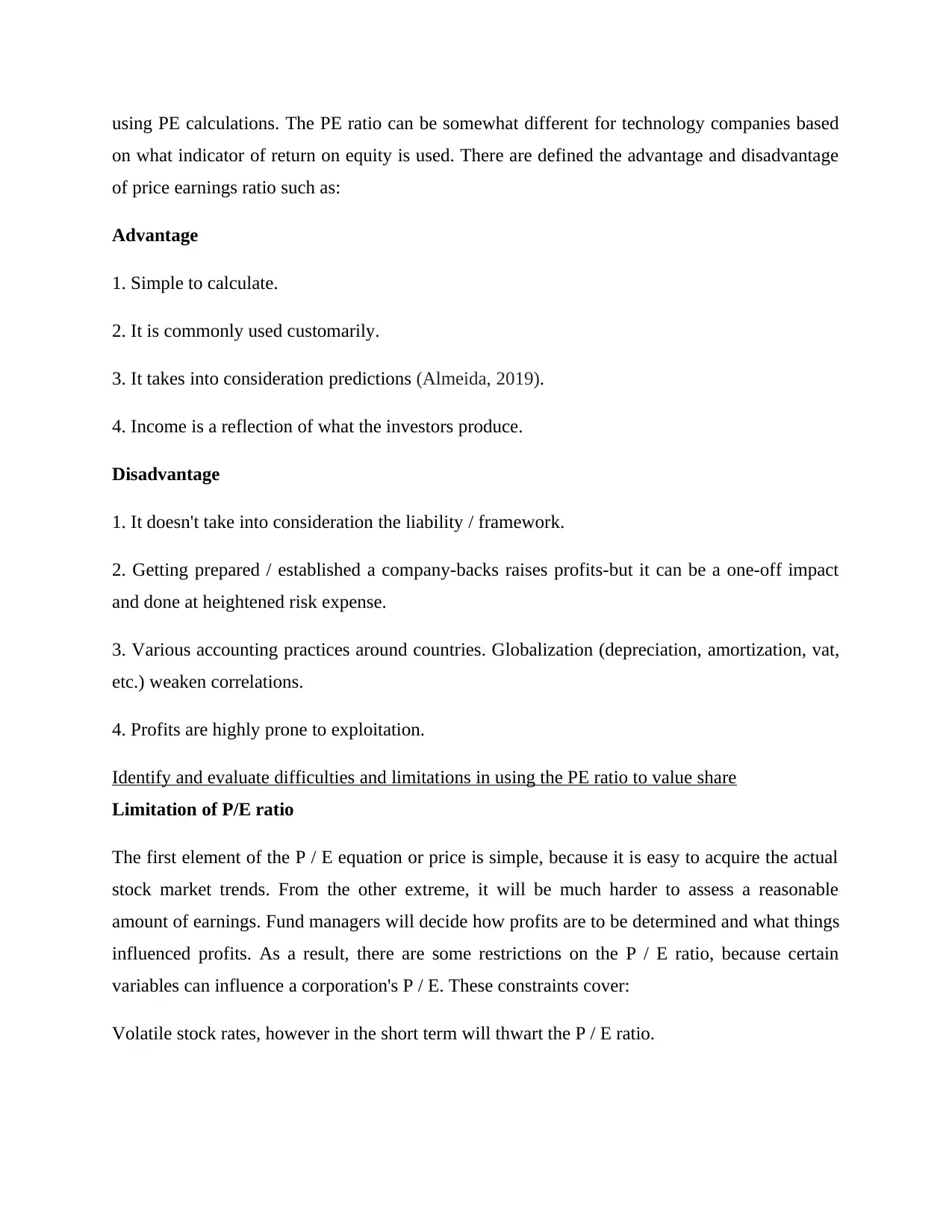
using PE calculations. The PE ratio can be somewhat different for technology companies based
on what indicator of return on equity is used. There are defined the advantage and disadvantage
of price earnings ratio such as:
Advantage
1. Simple to calculate.
2. It is commonly used customarily.
3. It takes into consideration predictions (Almeida, 2019).
4. Income is a reflection of what the investors produce.
Disadvantage
1. It doesn't take into consideration the liability / framework.
2. Getting prepared / established a company-backs raises profits-but it can be a one-off impact
and done at heightened risk expense.
3. Various accounting practices around countries. Globalization (depreciation, amortization, vat,
etc.) weaken correlations.
4. Profits are highly prone to exploitation.
Identify and evaluate difficulties and limitations in using the PE ratio to value share
Limitation of P/E ratio
The first element of the P / E equation or price is simple, because it is easy to acquire the actual
stock market trends. From the other extreme, it will be much harder to assess a reasonable
amount of earnings. Fund managers will decide how profits are to be determined and what things
influenced profits. As a result, there are some restrictions on the P / E ratio, because certain
variables can influence a corporation's P / E. These constraints cover:
Volatile stock rates, however in the short term will thwart the P / E ratio.
on what indicator of return on equity is used. There are defined the advantage and disadvantage
of price earnings ratio such as:
Advantage
1. Simple to calculate.
2. It is commonly used customarily.
3. It takes into consideration predictions (Almeida, 2019).
4. Income is a reflection of what the investors produce.
Disadvantage
1. It doesn't take into consideration the liability / framework.
2. Getting prepared / established a company-backs raises profits-but it can be a one-off impact
and done at heightened risk expense.
3. Various accounting practices around countries. Globalization (depreciation, amortization, vat,
etc.) weaken correlations.
4. Profits are highly prone to exploitation.
Identify and evaluate difficulties and limitations in using the PE ratio to value share
Limitation of P/E ratio
The first element of the P / E equation or price is simple, because it is easy to acquire the actual
stock market trends. From the other extreme, it will be much harder to assess a reasonable
amount of earnings. Fund managers will decide how profits are to be determined and what things
influenced profits. As a result, there are some restrictions on the P / E ratio, because certain
variables can influence a corporation's P / E. These constraints cover:
Volatile stock rates, however in the short term will thwart the P / E ratio.
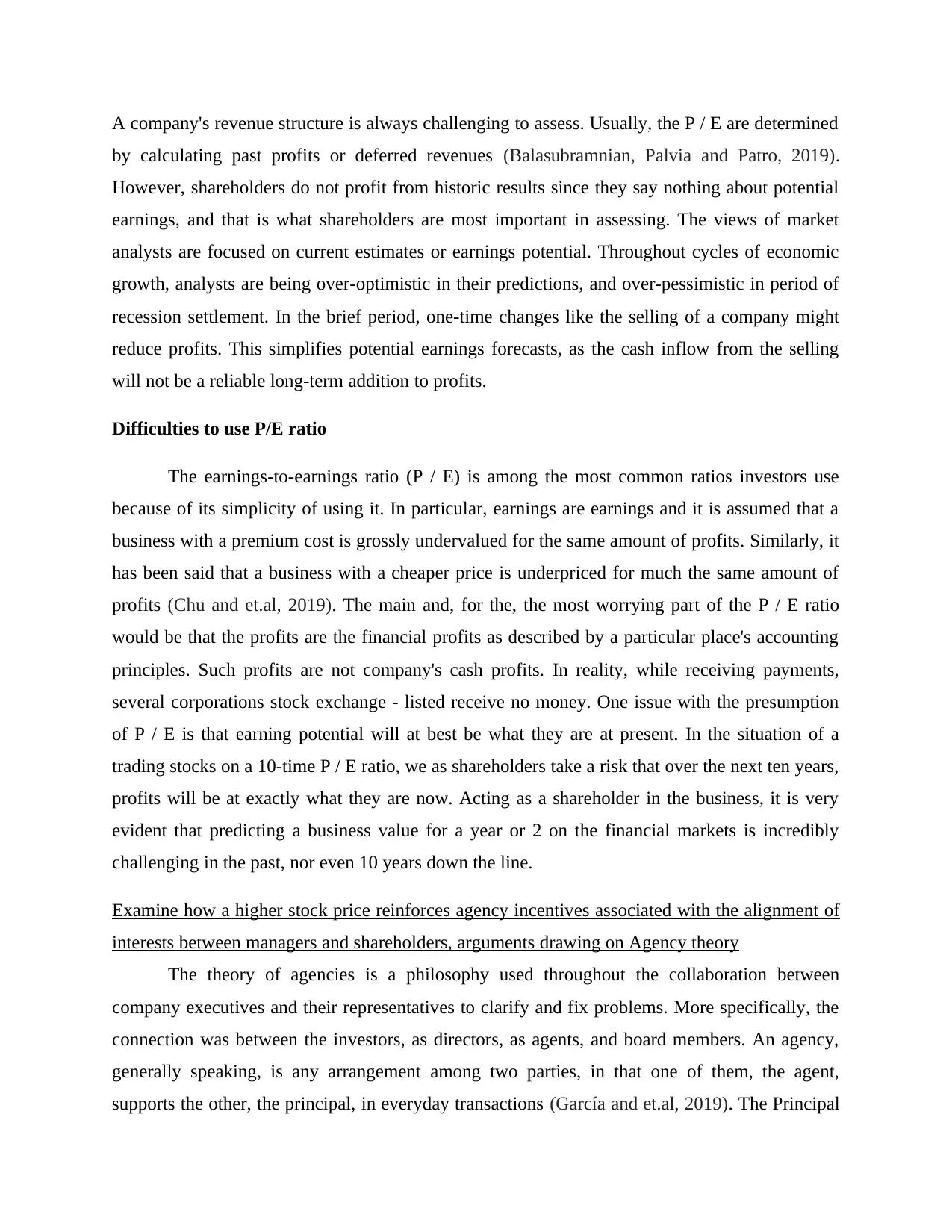
A company's revenue structure is always challenging to assess. Usually, the P / E are determined
by calculating past profits or deferred revenues (Balasubramnian, Palvia and Patro, 2019).
However, shareholders do not profit from historic results since they say nothing about potential
earnings, and that is what shareholders are most important in assessing. The views of market
analysts are focused on current estimates or earnings potential. Throughout cycles of economic
growth, analysts are being over-optimistic in their predictions, and over-pessimistic in period of
recession settlement. In the brief period, one-time changes like the selling of a company might
reduce profits. This simplifies potential earnings forecasts, as the cash inflow from the selling
will not be a reliable long-term addition to profits.
Difficulties to use P/E ratio
The earnings-to-earnings ratio (P / E) is among the most common ratios investors use
because of its simplicity of using it. In particular, earnings are earnings and it is assumed that a
business with a premium cost is grossly undervalued for the same amount of profits. Similarly, it
has been said that a business with a cheaper price is underpriced for much the same amount of
profits (Chu and et.al, 2019). The main and, for the, the most worrying part of the P / E ratio
would be that the profits are the financial profits as described by a particular place's accounting
principles. Such profits are not company's cash profits. In reality, while receiving payments,
several corporations stock exchange - listed receive no money. One issue with the presumption
of P / E is that earning potential will at best be what they are at present. In the situation of a
trading stocks on a 10-time P / E ratio, we as shareholders take a risk that over the next ten years,
profits will be at exactly what they are now. Acting as a shareholder in the business, it is very
evident that predicting a business value for a year or 2 on the financial markets is incredibly
challenging in the past, nor even 10 years down the line.
Examine how a higher stock price reinforces agency incentives associated with the alignment of
interests between managers and shareholders, arguments drawing on Agency theory
The theory of agencies is a philosophy used throughout the collaboration between
company executives and their representatives to clarify and fix problems. More specifically, the
connection was between the investors, as directors, as agents, and board members. An agency,
generally speaking, is any arrangement among two parties, in that one of them, the agent,
supports the other, the principal, in everyday transactions (García and et.al, 2019). The Principal
by calculating past profits or deferred revenues (Balasubramnian, Palvia and Patro, 2019).
However, shareholders do not profit from historic results since they say nothing about potential
earnings, and that is what shareholders are most important in assessing. The views of market
analysts are focused on current estimates or earnings potential. Throughout cycles of economic
growth, analysts are being over-optimistic in their predictions, and over-pessimistic in period of
recession settlement. In the brief period, one-time changes like the selling of a company might
reduce profits. This simplifies potential earnings forecasts, as the cash inflow from the selling
will not be a reliable long-term addition to profits.
Difficulties to use P/E ratio
The earnings-to-earnings ratio (P / E) is among the most common ratios investors use
because of its simplicity of using it. In particular, earnings are earnings and it is assumed that a
business with a premium cost is grossly undervalued for the same amount of profits. Similarly, it
has been said that a business with a cheaper price is underpriced for much the same amount of
profits (Chu and et.al, 2019). The main and, for the, the most worrying part of the P / E ratio
would be that the profits are the financial profits as described by a particular place's accounting
principles. Such profits are not company's cash profits. In reality, while receiving payments,
several corporations stock exchange - listed receive no money. One issue with the presumption
of P / E is that earning potential will at best be what they are at present. In the situation of a
trading stocks on a 10-time P / E ratio, we as shareholders take a risk that over the next ten years,
profits will be at exactly what they are now. Acting as a shareholder in the business, it is very
evident that predicting a business value for a year or 2 on the financial markets is incredibly
challenging in the past, nor even 10 years down the line.
Examine how a higher stock price reinforces agency incentives associated with the alignment of
interests between managers and shareholders, arguments drawing on Agency theory
The theory of agencies is a philosophy used throughout the collaboration between
company executives and their representatives to clarify and fix problems. More specifically, the
connection was between the investors, as directors, as agents, and board members. An agency,
generally speaking, is any arrangement among two parties, in that one of them, the agent,
supports the other, the principal, in everyday transactions (García and et.al, 2019). The Principal
⊘ This is a preview!⊘
Do you want full access?
Subscribe today to unlock all pages.

Trusted by 1+ million students worldwide
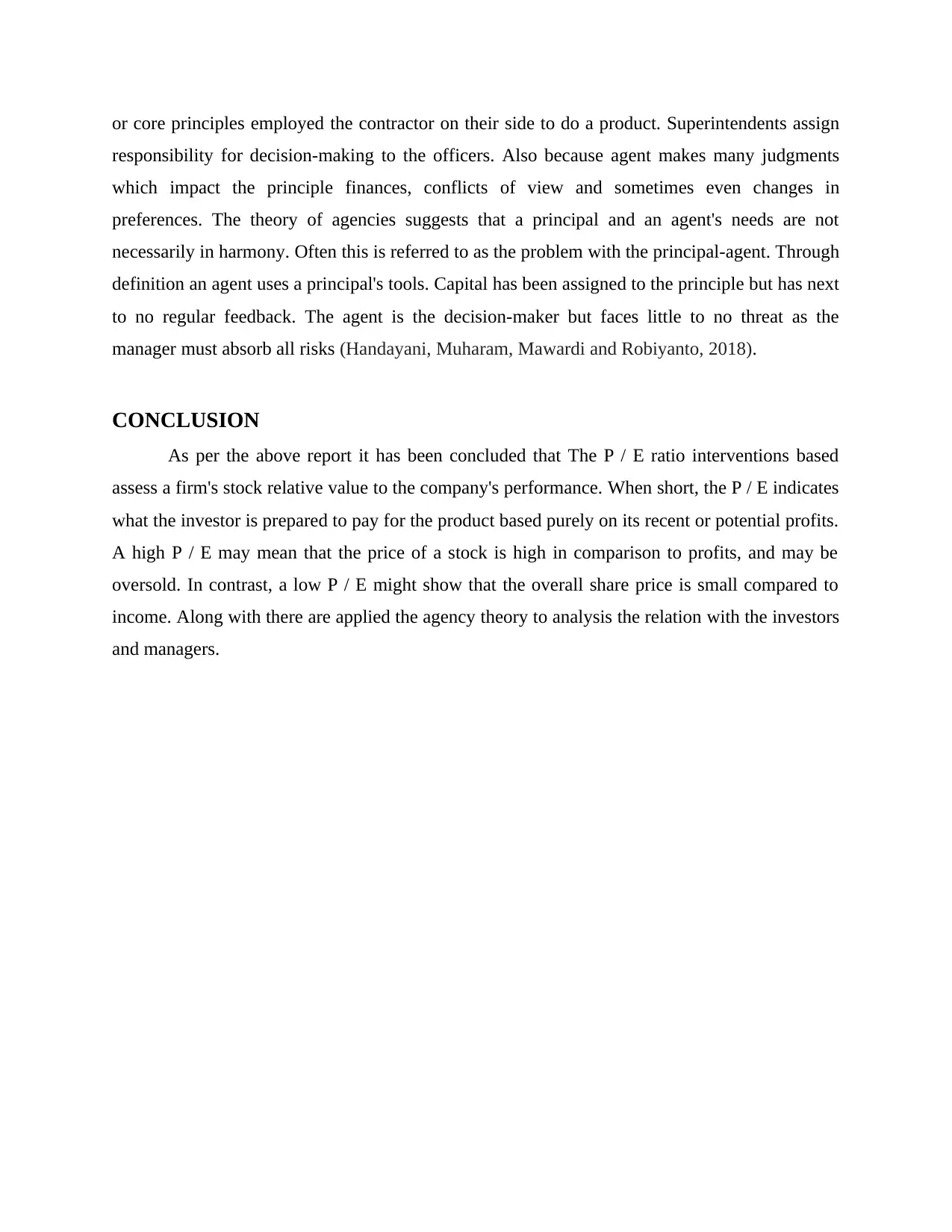
or core principles employed the contractor on their side to do a product. Superintendents assign
responsibility for decision-making to the officers. Also because agent makes many judgments
which impact the principle finances, conflicts of view and sometimes even changes in
preferences. The theory of agencies suggests that a principal and an agent's needs are not
necessarily in harmony. Often this is referred to as the problem with the principal-agent. Through
definition an agent uses a principal's tools. Capital has been assigned to the principle but has next
to no regular feedback. The agent is the decision-maker but faces little to no threat as the
manager must absorb all risks (Handayani, Muharam, Mawardi and Robiyanto, 2018).
CONCLUSION
As per the above report it has been concluded that The P / E ratio interventions based
assess a firm's stock relative value to the company's performance. When short, the P / E indicates
what the investor is prepared to pay for the product based purely on its recent or potential profits.
A high P / E may mean that the price of a stock is high in comparison to profits, and may be
oversold. In contrast, a low P / E might show that the overall share price is small compared to
income. Along with there are applied the agency theory to analysis the relation with the investors
and managers.
responsibility for decision-making to the officers. Also because agent makes many judgments
which impact the principle finances, conflicts of view and sometimes even changes in
preferences. The theory of agencies suggests that a principal and an agent's needs are not
necessarily in harmony. Often this is referred to as the problem with the principal-agent. Through
definition an agent uses a principal's tools. Capital has been assigned to the principle but has next
to no regular feedback. The agent is the decision-maker but faces little to no threat as the
manager must absorb all risks (Handayani, Muharam, Mawardi and Robiyanto, 2018).
CONCLUSION
As per the above report it has been concluded that The P / E ratio interventions based
assess a firm's stock relative value to the company's performance. When short, the P / E indicates
what the investor is prepared to pay for the product based purely on its recent or potential profits.
A high P / E may mean that the price of a stock is high in comparison to profits, and may be
oversold. In contrast, a low P / E might show that the overall share price is small compared to
income. Along with there are applied the agency theory to analysis the relation with the investors
and managers.
Paraphrase This Document
Need a fresh take? Get an instant paraphrase of this document with our AI Paraphraser
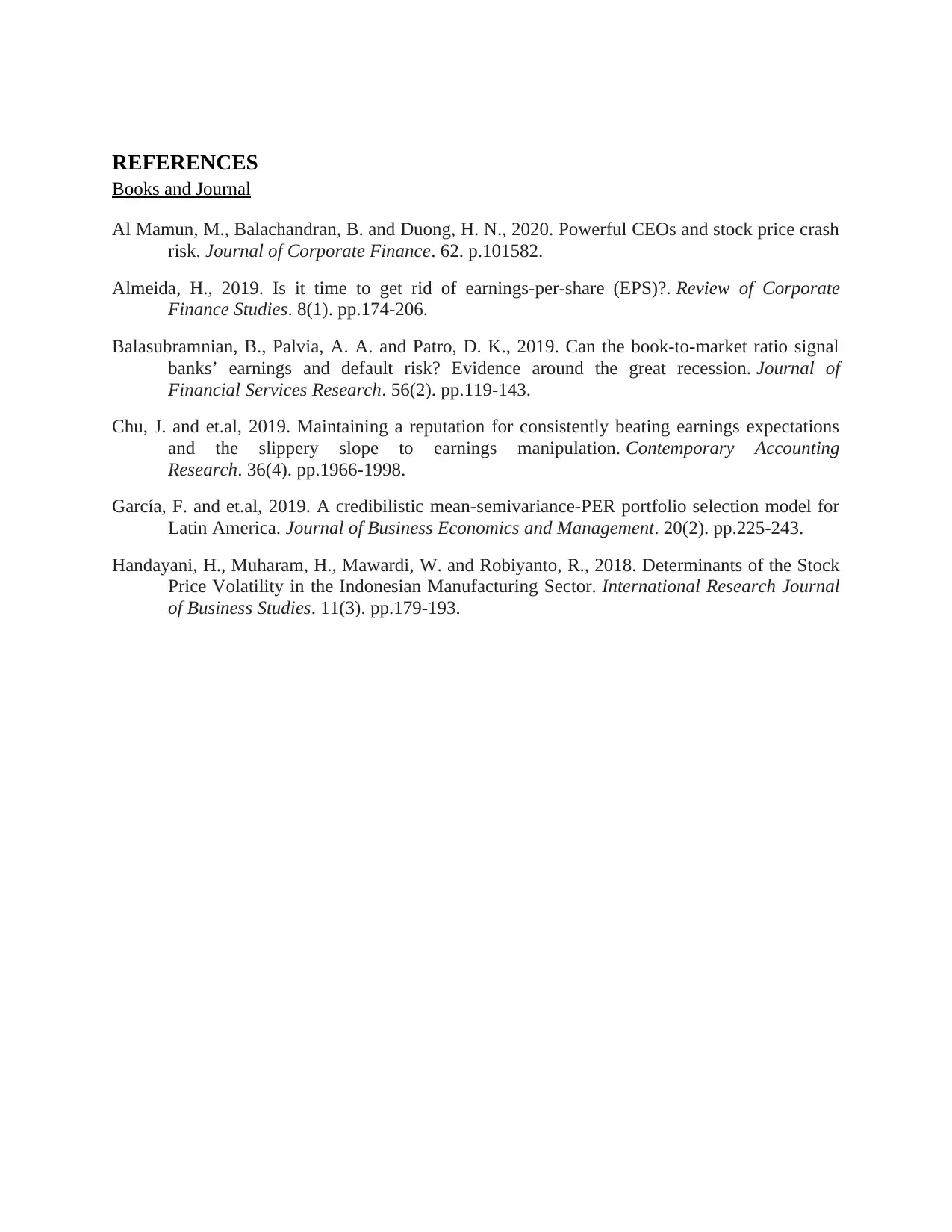
REFERENCES
Books and Journal
Al Mamun, M., Balachandran, B. and Duong, H. N., 2020. Powerful CEOs and stock price crash
risk. Journal of Corporate Finance. 62. p.101582.
Almeida, H., 2019. Is it time to get rid of earnings-per-share (EPS)?. Review of Corporate
Finance Studies. 8(1). pp.174-206.
Balasubramnian, B., Palvia, A. A. and Patro, D. K., 2019. Can the book-to-market ratio signal
banks’ earnings and default risk? Evidence around the great recession. Journal of
Financial Services Research. 56(2). pp.119-143.
Chu, J. and et.al, 2019. Maintaining a reputation for consistently beating earnings expectations
and the slippery slope to earnings manipulation. Contemporary Accounting
Research. 36(4). pp.1966-1998.
García, F. and et.al, 2019. A credibilistic mean-semivariance-PER portfolio selection model for
Latin America. Journal of Business Economics and Management. 20(2). pp.225-243.
Handayani, H., Muharam, H., Mawardi, W. and Robiyanto, R., 2018. Determinants of the Stock
Price Volatility in the Indonesian Manufacturing Sector. International Research Journal
of Business Studies. 11(3). pp.179-193.
Books and Journal
Al Mamun, M., Balachandran, B. and Duong, H. N., 2020. Powerful CEOs and stock price crash
risk. Journal of Corporate Finance. 62. p.101582.
Almeida, H., 2019. Is it time to get rid of earnings-per-share (EPS)?. Review of Corporate
Finance Studies. 8(1). pp.174-206.
Balasubramnian, B., Palvia, A. A. and Patro, D. K., 2019. Can the book-to-market ratio signal
banks’ earnings and default risk? Evidence around the great recession. Journal of
Financial Services Research. 56(2). pp.119-143.
Chu, J. and et.al, 2019. Maintaining a reputation for consistently beating earnings expectations
and the slippery slope to earnings manipulation. Contemporary Accounting
Research. 36(4). pp.1966-1998.
García, F. and et.al, 2019. A credibilistic mean-semivariance-PER portfolio selection model for
Latin America. Journal of Business Economics and Management. 20(2). pp.225-243.
Handayani, H., Muharam, H., Mawardi, W. and Robiyanto, R., 2018. Determinants of the Stock
Price Volatility in the Indonesian Manufacturing Sector. International Research Journal
of Business Studies. 11(3). pp.179-193.
1 out of 8
Related Documents
Your All-in-One AI-Powered Toolkit for Academic Success.
+13062052269
info@desklib.com
Available 24*7 on WhatsApp / Email
![[object Object]](/_next/static/media/star-bottom.7253800d.svg)
Unlock your academic potential
Copyright © 2020–2025 A2Z Services. All Rights Reserved. Developed and managed by ZUCOL.




